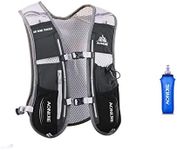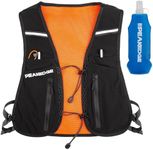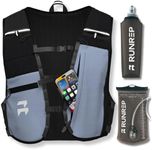Buying Guide for the Best Running Water Vest
Choosing the right running water vest is crucial for ensuring comfort, hydration, and performance during your runs. A running water vest is designed to carry water and other essentials while keeping your hands free and distributing weight evenly across your body. When selecting a running water vest, consider the following key specifications to find the best fit for your needs.CapacityCapacity refers to the amount of water and gear the vest can hold. This is important because it determines how much hydration and supplies you can carry during your run. Vests typically range from small capacities (1-2 liters) for short runs to larger capacities (8-12 liters) for long-distance or ultra runs. If you are a casual runner or participate in shorter races, a smaller capacity vest will suffice. For longer runs or trail running, opt for a vest with a larger capacity to ensure you have enough hydration and space for essentials like snacks, extra clothing, and safety gear.
Fit and ComfortFit and comfort are crucial for preventing chafing and ensuring the vest stays in place during your run. A well-fitting vest should be snug but not restrictive, allowing for a full range of motion. Look for adjustable straps and multiple sizing options to find the best fit for your body type. If you plan to run long distances, prioritize vests with padded straps and breathable materials to enhance comfort and reduce irritation.
Hydration SystemThe hydration system refers to how the vest holds and dispenses water. Common options include hydration bladders with drinking tubes or multiple water bottle pockets. This spec is important because it affects how easily you can access water while running. Hydration bladders are ideal for continuous sipping and hands-free hydration, while bottle pockets allow for easy refilling and monitoring of water intake. Choose a hydration system based on your preference for ease of use and the type of runs you do. For longer runs, a bladder may be more convenient, while shorter runs might benefit from bottle pockets.
Storage and OrganizationStorage and organization refer to the number and type of pockets and compartments available in the vest. This is important for carrying essentials like keys, phone, nutrition, and first aid supplies. Vests with multiple pockets and compartments help keep items organized and easily accessible. Consider your specific needs: if you carry minimal gear, a vest with fewer pockets will be sufficient. For trail running or long-distance events, look for vests with ample storage options to accommodate all necessary items.
Material and DurabilityMaterial and durability are important for ensuring the vest can withstand the rigors of running and various weather conditions. Look for vests made from lightweight, breathable, and moisture-wicking materials to keep you comfortable. Durability is key for long-term use, so choose vests with reinforced stitching and high-quality zippers. If you run in diverse environments, consider vests with water-resistant or quick-drying properties to protect your gear and keep you dry.
WeightWeight refers to how heavy the vest is when empty. This is important because a lighter vest will be more comfortable and less cumbersome during your run. Vests range from ultra-light models designed for speed and minimalism to more robust options with additional features and storage. If you prioritize speed and agility, opt for a lighter vest. For longer runs where you need to carry more gear, a slightly heavier vest with more features may be necessary.
















